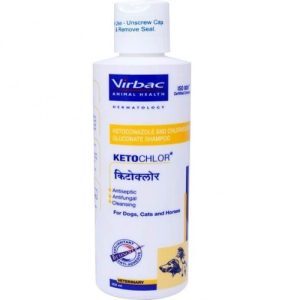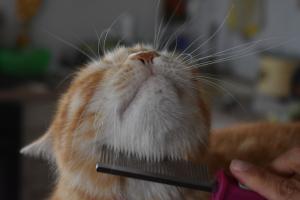Table of Contents
Ketochlor is a valuable solution for treating dermatitis caused by both bacterial and fungal sources. It is the preferred topical choice for managing complications associated with these skin conditions in dogs, cats, and horses.

What Is Ketochlor?
Ketochlor is a specialized medicated shampoo by Virbac designed to combat fungal and bacterial issues while promoting a healthy skin environment. Its key ingredients, ketoconazole and chlorhexidine gluconate, are highly effective in addressing skin rashes, infections, and itching in dogs, cats, and horses. Ketochlor is specifically formulated to restore the natural microbial balance of the skin. To achieve optimal results, leaving the shampoo on the coat for 5-10 minutes before rinsing is recommended.
Ingredients
- Chlorhexidine Gluconate IP (2%);
- Ketoconazole IP (1%);
- Glycotechnology;
- Chitosanide.
Instructions for Use
- Before use, ensure to shake the shampoo well.
- Begin by wetting the coat with warm water.
- Apply a proper amount of shampoo to create a luxurious lather, gently massaging it into the wet coat.
- Allow the lather to remain on the coat for a minimum of 5 to 10 minutes.
- Thoroughly rinse the coat with clean water.
- Initially, you may use the shampoo 2 to 3 times a week for four weeks.
- After the initial treatment phase, reduce usage to once a week or as your veterinarian directs for ongoing maintenance.
Important Safety Information for Pet Owners
Before using Ketochlor or any medicated shampoo on your pet, it is essential to consult your veterinarian. They can guide the appropriate usage and ensure it is the right choice for your pet’s specific condition.
When applying Ketochlor, avoid contact with your pet’s eyes. In case of accidental eye contact, rinse thoroughly with clean water and seek veterinary advice if irritation persists.
Ketochlor is intended for external use only. Keep it out of the reach of children and pets to prevent accidental ingestion.
Monitor your pet for any signs of allergic reactions such as redness, swelling, or itching. If any adverse reactions occur, discontinue use immediately and consult your veterinarian.
Adhere to the provided usage instructions carefully. Use the recommended amount of shampoo and allow it to stay on the coat for the specified time for best results.
If your pet is pregnant, nursing, or has underlying health conditions, inform your veterinarian before using Ketochlor to ensure it is safe and appropriate for your pet’s situation.
While Ketochlor may require more frequent use for certain conditions, avoid overusing it without veterinary guidance, as excessive use may lead to skin irritation.
Avoid using other shampoos or skin treatments simultaneously with Ketochlor unless directed by your veterinarian, as this may interfere with the product’s effectiveness.
Regularly consult your veterinarian during treatment to ensure the best outcome for your pet’s skin condition.
Ketochlor is a valuable tool in managing skin issues in your pets, but ensuring safety and efficacy requires responsible use and consultation with a veterinary professional. Always prioritize your pet’s well-being and follow professional advice for their care.
Ketochlor is typically available as a non-prescription (over-the-counter) product. It is often sold in pet supply stores, online pet pharmacies, or through veterinarians without a prescription. However, regulations and product availability may vary by country, region, or specific circumstances.
Veterinary Prescription
You must check with your local regulations and the specific retailer or pharmacy where you plan to purchase Ketochlor. In some cases, veterinarians may recommend and prescribe Ketochlor based on your pet’s specific condition or as part of a broader treatment plan.
Always consult your veterinarian before using any medicated shampoo or product on your pet to ensure it is the most appropriate choice for their condition and to receive guidance on its proper usage. They can also advise you on where to obtain the product in accordance with local regulations and your pet’s specific needs.

Interactions
Ketochlor is a medicated shampoo primarily used for topical treatment of bacterial and fungal dermatitis in dogs, cats, and horses. Since it’s intended for external use on the skin and coat, it generally has minimal interactions with other medications or substances. However, here are some considerations:
- Other Topical Products: When using Ketochlor, it’s generally best to avoid using other topical products on your pet’s skin simultaneously unless directed by your veterinarian. Using multiple topical products at once can interfere with each other’s effectiveness or cause skin irritation.
- Medication Absorption: While Ketochlor is a topical product, it’s important to note that certain medications can be absorbed through the skin to a limited extent. If your pet takes oral medications, inform your veterinarian, as they can guide potential interactions or adjustments in the treatment plan.
- Allergic Reactions: If you notice any signs of allergic reactions or increased skin irritation when using Ketochlor alongside other products, discontinue use and consult your veterinarian immediately.
- Pre-existing Skin Conditions: If your pet has pre-existing skin conditions or is on long-term medications for skin issues, consult your veterinarian to ensure that using Ketochlor won’t interfere with their existing treatment plan.
- Sensitive or Irritated Skin: If your pet’s skin is particularly sensitive or irritated due to other factors, it’s essential to be cautious when using any topical product, including Ketochlor. Consult your veterinarian for guidance on managing such cases.
- Pregnancy or Nursing: If your pet is pregnant, nursing, or has underlying health conditions, inform your veterinarian before using Ketochlor to ensure it is safe and appropriate for your pet’s situation.
Remember that the potential for interactions can vary based on individual circumstances, so it’s crucial to involve your veterinarian in the decision-making process to ensure the safety and efficacy of any treatment plan involving Ketochlor or other medications.
Side Effects
Ketochlor is generally considered safe when applied topically according to the instructions. However, like any medication or product, there is a potential for side effects, although they are typically rare. If you notice any unusual reactions or side effects in your pet after using Ketochlor, discontinue use and consult your veterinarian. Common side effects may include:
- Skin Irritation: Some pets may experience mild skin irritation, redness, or itching after using Ketochlor. This is generally temporary and should resolve on its own. If the irritation persists or worsens, consult your veterinarian.
- Allergic Reactions: In rare cases, a pet may have an allergic reaction to one of the ingredients in Ketochlor. Signs of an allergic reaction can include swelling, hives, difficulty breathing, or severe itching. If you observe any of these symptoms, seek immediate veterinary attention.
- Excessive Dryness: Ketochlor may cause dryness in the skin and coat in some pets. This can typically be managed using a moisturizing pet conditioner or following your veterinarian’s recommendations.
- Changes in Coat Color or Texture: Some pets may experience temporary changes in the color or texture of their coat after using Ketochlor. These changes are usually minor and should revert to normal over time.
- Eye Irritation: Be cautious when applying Ketochlor near your pet’s eyes, as accidental contact can cause irritation. If this occurs, rinse the eyes thoroughly with clean water and seek veterinary advice if the irritation persists.
- Vomiting or Ingestion: While Ketochlor is meant for external use, there is a risk that your pet may ingest a small amount if they lick themselves after treatment. Ingesting Ketochlor can lead to stomach upset or vomiting. If you suspect your pet has ingested a significant amount, contact your veterinarian.
It’s essential to follow the recommended usage guidelines for Ketochlor, including the proper duration of contact with your pet’s skin and coat, as specified in the instructions. If you have any concerns about potential side effects or if your pet’s condition worsens after using Ketochlor, do not hesitate to contact your veterinarian.
Overdose
Ketochlor is not meant to be ingested, and an overdose of Ketochlor can occur if your pet licks or ingests a significant amount of the shampoo. If you suspect an overdose of Ketochlor, here are the steps to take:
- Contact Your Veterinarian: If you believe your pet has ingested a large amount of Ketochlor or if you are unsure of the extent of the ingestion, immediately contact your veterinarian or an emergency veterinary clinic. They can provide guidance and advice on how to proceed.
- Do Not Induce Vomiting: Do not attempt to induce vomiting in your pet unless specifically instructed by a veterinarian. Some substances can be harmful if vomited back up.
- Provide Information: When contacting your veterinarian, be prepared to provide information about your pet’s size, weight, and the approximate amount of Ketochlor that was ingested. This information will help them assess the situation.
- Monitor Your Pet: Keep a close eye on your pet for any signs of distress, illness, or unusual behavior. Symptoms of an overdose may vary depending on the amount ingested and the individual pet’s sensitivity to the ingredients.
- Follow Veterinary Advice: Follow the guidance and instructions provided by your veterinarian. They may recommend specific treatments or interventions based on the severity of the overdose and your pet’s condition.
It’s essential to prevent your pet from ingesting any more Ketochlor and to keep the product out of their reach in the future. Remember that prevention is the best approach to avoiding accidental overdoses.
Storage
Store Ketochlor in a cool, dry place. Avoid exposure to direct sunlight and extreme temperatures, as this can affect the stability of the product. A room-temperature storage area is ideal.
Ensure that the cap or lid of the Ketochlor bottle is securely closed after each use. This helps prevent contamination and maintains the product’s integrity. It’s generally best to store Ketochlor in its original container to prevent confusion with other products. The original packaging typically contains essential information, such as usage instructions and expiration dates.
Store Ketochlor out of the reach of children and pets. This helps prevent accidental ingestion or misuse of the product. If you have small children or pets, consider using childproof locks or cabinets to store Ketochlor safely.
Always check the expiration date on the product before use. Do not use Ketochlor if it has expired, as it may not be as effective or safe. Do not mix Ketochlor with other products or shampoos unless specifically directed by your veterinarian. Mixing products can alter their effectiveness and safety.
FAQ
How often should I use Ketochlor on my pet?
Initially, Ketochlor can be used 2 to 3 times a week for four weeks. Afterward, you can reduce usage to once a week or follow your veterinarian’s recommendations.
Can I use Ketochlor on puppies and kittens?
Please consult your veterinarian before using Ketochlor on puppies or kittens, as they may have specific recommendations based on your pet’s age and condition.
Can I use Ketochlor with other shampoos or treatments?
It’s generally best to avoid using other topical products simultaneously with Ketochlor unless directed by your veterinarian, as this may affect its effectiveness.
How long should I leave Ketochlor on my pet’s coat before rinsing?
For best results, allow Ketochlor to remain on the coat for 5-10 minutes before rinsing it thoroughly with clean water.
Is Ketochlor safe for pregnant or nursing pets?
Inform your veterinarian if your pet is pregnant, nursing, or has underlying health conditions before using Ketochlor to ensure it is safe and appropriate.

































